

Adolescent risk taking - Big Ideas. Why the Teen Brain Is Drawn to Risk. If you’re the parent of a tween, be warned: your cautious 10-year-old is bound to turn into a wild child in a few short years, with seemingly no regard whatsoever for safety.

Indeed, teenagers have the double the risk of dying compared to their preteen selves. Adults have long reckoned with ways to protect adolescents from their own misjudgments. Only recently, however, have researchers really begun to understand how the teen brain is wired and that some of what appear to be teens’ senseless choices may result from biological tendencies that also prime their brains to learn and be flexible. Take teens’ perception of risk. It’s certainly different from that of adults, but not in the ways you’d expect. “Relative to adults, adolescents engage more in unknown risks than they do in known risks,” says Agnieszka Tymula, a postdoctoral student at New York University and the lead author of the study, which was published in the Proceedings of the National Academy of Sciences.
Risk Taking Behaviour » Me, Mood, Get Active. Cocaine 'speeds up' the brain, which helps you stay alert and awake, and sometimes provides an 'energy burst'.
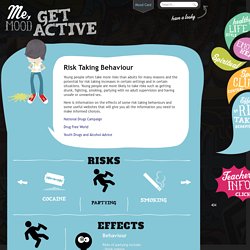
It is also a pain reliever. It is illegal to possess or use cocaine in Australia. If you are caught with even a small amount you can be arrested and it could lead to a criminal record. As we get older, being social and hanging out with friends becomes extremely important to young people. Teenagers in particular like to party, and this could include clubbing, concerts or festivals, or having a party at home or at a friend’s house. Smoking is the habit which often starts in adolescence. People who start smoking in their teens are more likely to become regular smokers and suffer from smoke related diseases. Cannabis is the most common illicit drug used by young Australians. Adolescent Risktaking fact sheet. Understanding Risk-taking Behaviour. Risk Taking by Young People - ABS - 2008. Youth is a stage of life characterised by rapid psychological and physical transition, where young people progress from being dependent children to independent adults.

Young people may be inclined to experiment and take risks that could impact on their own health and wellbeing and have consequences for others. This article examines behaviours such as risky drinking, illicit drug use and dangerous driving by people aged 15-24 years. It also looks at some of the potential consequences of these behaviours, including being charged with criminal offences, hospitalisation and death. Youth is a period characterised by rapid psychological and physical transition, where young people progress from being dependent children to independent adults. This transition period has been made more complex by the social, economic and technological changes that have occurred in Australia over recent decades. 1 In 2007, there were 2.9 million people aged 15-24 years, making up 14% of the total population.
Teenagers Are No More Risk-Taking Than Children. For a change, I thought this week instead of writing about black widow spiders or praying mantids I’d write about an animal I often neglect: humans.
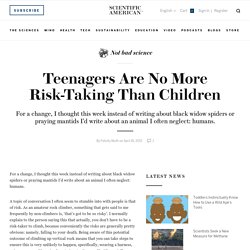
A topic of conversation I often seem to stumble into with people is that of risk. As an amateur rock climber, something that gets said to me frequently by non-climbers is, ‘that’s got to be so risky’. I normally explain to the person saying this that actually, you don’t have to be a risk-taker to climb, because conveniently the risks are generally pretty obvious: namely, falling to your death. Being aware of this potential outcome of climbing up vertical rock means that you can take steps to ensure this is very unlikely to happen, specifically, wearing a harness, using a rope, and learning how to ‘protect’ yourself with specially-designed equipment.
Healthy Risk-Taking Behavior in Adolescent Girls. Topic: Healthy Risk-Taking Behavior in Adolescent Girls (MP3, 8.8MB) Recorded by: Aliya Khan Length: 8 minutes, 56 seconds.
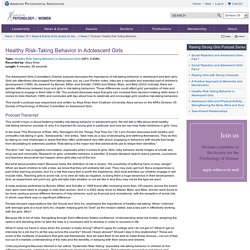
Why the Teen Brain Is Drawn to Risk. Adolescence and Risk-Taking. Boys WILL be boys. Risk-taking behaviour of young women in Australia: screening for health-risk behaviours. Identifying risk and protective factors The optimal adolescent consultation involves making an assessment of the young person's level of functioning and risk in a number of areas.
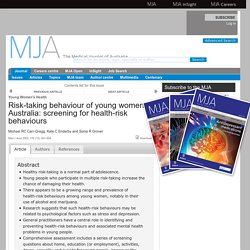
In his (unpublished) Howard Williams memorial oration, delivered at the 1998 Royal Australasian College of Physicians Annual Conference in Christchurch, New Zealand, Court conceptualised the "four worlds of an adolescent" (family, school, peer and inner) as the important influences on an adolescent's life. Exploration of each area (Box 2) provides a comprehensive picture of the young person's current experience, and helps in making an informed assessment of the person's health. The addition of community and cultural worlds is also recommended, especially when working in a multicultural setting. A Social Neuroscience Perspective on Adolescent Risk-Taking. Adolescents’ risk-taking behavior is driven by tolerance to ambiguity. Author Affiliations Edited by Michael S.

Risky behaviour in teens: how to handle it. Looking for new experiences is normal for teenagers, and sometimes it involves thrill-seeking or even risky behaviour.
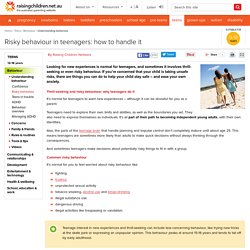
If you’re concerned that your child is taking unsafe risks, there are things you can do to help your child stay safe – and ease your own anxiety. Thrill-seeking and risky behaviour: why teenagers do it It’s normal for teenagers to want new experiences – although it can be stressful for you as a parent. Teenagers need to explore their own limits and abilities, as well as the boundaries you set. They also need to express themselves as individuals. Also, the parts of the teenage brain that handle planning and impulse control don’t completely mature until about age 25. And sometimes teenagers make decisions about potentially risky things to fit in with a group.
Common risky behaviour It’s normal for you to feel worried about risky behaviour like: Keeping your child safe.